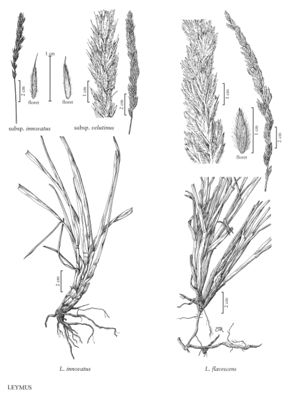familyPoaceae
subfamilyPoaceae subfam. Pooideae
genusLeymus
speciesLeymus innovatus
subspeciesLeymus innovatus subsp. innovatus
Difference between revisions of "Leymus innovatus subsp. innovatus"
Treatment appears in FNA Volume 24. Treatment on page 366.
FNA>Volume Importer |
imported>Volume Importer |
||
| (5 intermediate revisions by 2 users not shown) | |||
| Line 1: | Line 1: | ||
{{Treatment/ID | {{Treatment/ID | ||
|accepted_name=Leymus innovatus subsp. innovatus | |accepted_name=Leymus innovatus subsp. innovatus | ||
| − | |accepted_authority= | + | |accepted_authority= |
|publications= | |publications= | ||
|basionyms= | |basionyms= | ||
| Line 24: | Line 24: | ||
-->{{#Taxon: | -->{{#Taxon: | ||
name=Leymus innovatus subsp. innovatus | name=Leymus innovatus subsp. innovatus | ||
| − | + | |authority= | |
| − | |authority= | ||
|rank=subspecies | |rank=subspecies | ||
|parent rank=species | |parent rank=species | ||
| Line 31: | Line 30: | ||
|basionyms= | |basionyms= | ||
|family=Poaceae | |family=Poaceae | ||
| + | |illustrator=Cindy Roché | ||
| + | |illustration copyright=Utah State University | ||
|reference=None | |reference=None | ||
|publication title= | |publication title= | ||
|publication year= | |publication year= | ||
|special status= | |special status= | ||
| − | |source xml=https:// | + | |source xml=https://bitbucket.org/aafc-mbb/fna-data-curation/src/200273ad09963decb8fc72550212de541d86569d/coarse_grained_fna_xml/V24/V24_528.xml |
|subfamily=Poaceae subfam. Pooideae | |subfamily=Poaceae subfam. Pooideae | ||
|tribe=Poaceae tribe Triticeae | |tribe=Poaceae tribe Triticeae | ||
Latest revision as of 16:24, 11 May 2021
Spikes 8-16 cm long, 8-15 mm wide. Glumes present; lemma hairs 0.7-2.5 mm. 2n = 28.
Discussion
Leymus innovatus subsp. innovatus is the more widespread of the two subspecies, extending across North America from the southern Yukon Territory to Ontario, south in the Rocky Mountains to northern Montana, and, as a disjunct, to the Black Hills region of Wyoming and South Dakota. Closer study is needed to determine its range more exactly.
Selected References
None.
Lower Taxa
None.
